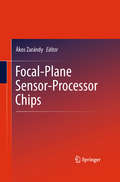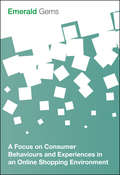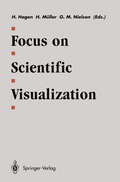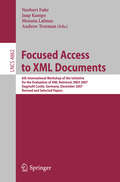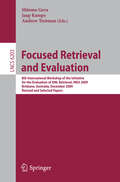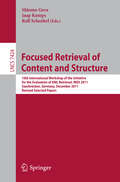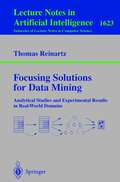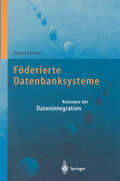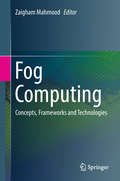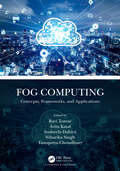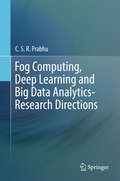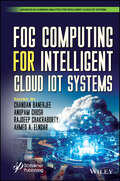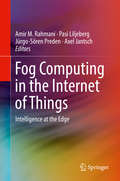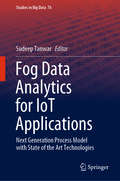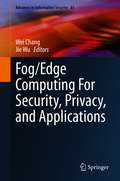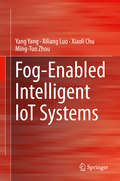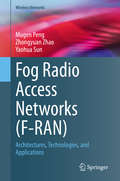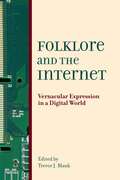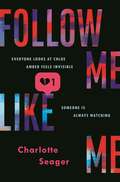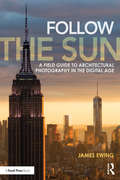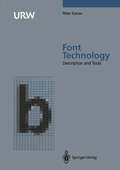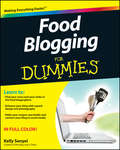- Table View
- List View
Focal-Plane Sensor-Processor Chips
by Ákos ZarándyFocal-plane sensor-processor imager devices are sensor arrays and processor arrays embedded in each other on the same silicon chip. This close coupling enables ultra-fast processing even on tiny, low power devices, because the slow and energetically expensive transfer of the large amount of sensory data is eliminated. This technology also makes it possible to produce locally adaptive sensor arrays, which can (similarly to the human retina) adapt to the large dynamics of the illumination in a single scene This book focuses on the implementation and application of state-of-the-art vision chips. It provides an overview of focal plane chip technology, smart imagers and cellular wave computers, along with numerous examples of current vision chips, 3D sensor-processor arrays and their applications. Coverage includes not only the technology behind the devices, but also their near- and mid-term research trends.
A Focus on Consumer Behaviours and Experiences in an Online Shopping Environment (Emerald Gems)
by Emerald Group LimitedA Focus on Consumer Behaviours and Experiences in an Online Shopping Environment is a collection of key articles on this topical area of increasing importance. This collection offers insights across a range of sectors. Some of the topics the book looks at include: - Influences of socioeconomic characteristics in online shopping behaviour- Impact of e-service quality, customer perceived value, and customer satisfaction on customer loyalty - The role trust plays in an online shopping environment - The effectiveness of online blogging on consumer purchase decisions In this digital era online shopping is more accessible than it has ever been before and as more people turn to the internet to buy goods and services it's important to understand the consumers' experiences and behaviours. Including articles from prestigious journals such as Internet Research and Journal of Services Marketing this book will be a valuable resource for researches, managers and professionals.
Focus on Scientific Visualization (Computer Graphics: Systems and Applications)
by Hans Hagen Heinrich Müller Gregory M. NielsonOne of the important issues of Scientific Visualization is the utilization of the broad bandwidth of the human sensory system in steering and interpreting complex processes and simulations involving voluminous data sets across diverse scientific disciplines. This book presents the state-of-the-art in visualization techniques both as an overview for the inquiring scientist, and as a solid platform from which developers may extend existing techniques or devise new ones to meet the specific needs of their problems. A secondary goal in crafting this volume has been to provide a vehicle for teaching of state-of-the-art techniques in scientific visualization. The first part of the book covers the application areas fluid flow visualization in medicine, and environmental protection. The second set of chapters explain fundamentals of scientific visualization. It comprises contributions on data structuring and data administration, data modeling, and rendering. A final section is devoted to auditory representation of scientific data.
Focused Access to XML Documents: 6th International Workshop of the Initiative for the Evaluation of XML Retrieval, INEX 2007, Dagstuhl Castle, Germany, December 17-19, 2007, Revised and Selected Papers (Lecture Notes in Computer Science #4862)
by Norbert Fuhr Jaap Kamps Mounia Lalmas Andrew TrotmanThis book constitutes the thoroughly refereed post-conference proceedings of the 6th International Workshop of the Initiative for the Evaluation of XML Retrieval, INEX 2007, held at Dagstuhl Castle, Germany, in December 2007. The 37 revised full papers presented were carefully reviewed and selected for presentation at the workshop from 50 initial submissions. The papers are organized in an ad hoc track and 6 topical sections on book search, XML-mining, entity ranking, interactive, link-the-wiki, and multimedia.
Focused Retrieval and Evaluation: 8th International Workshop of the Initiative for the Evaluation of XML Retrieval, INEX 2009, Brisbane, Australia, December 7-9, 2009, Revised and Selected Papers (Lecture Notes in Computer Science #6203)
by Shlomo Geva Jaap Kamps Andrew TrotmanFocused Retrieval of Content and Structure: 10th International Workshop of the Initiative for the Evaluation of XML Retrieval, INEX 2011, Saarbrücken, Germany, December 12-14, 2011, Revised and Selected Papers (Lecture Notes in Computer Science #7424)
by Shlomo Geva Jaap Kamps Ralf SchenkelThis book constitutes the thoroughly refereed post-workshop proceedings of the 10th International Workshop of the Initiative for the Evaluation of XML Retrieval, INEX 2011, held in Saarbrücken, Germany, in December 2011. The 33 revised full papers presented were carefully reviewed and selected for presentation at the workshop from 36 submissions. The papers are organized in 5 research tracks on book and social search, Xdata centric, question answering, relevance feedback, and snippet retrieval.
Focusing Solutions for Data Mining: Analytical Studies and Experimental Results in Real-World Domains (Lecture Notes in Computer Science #1623)
by Thomas ReinartzIn the first part, this book analyzes the knowledge discovery process in order to understand the relations between knowledge discovery steps and focusing. The part devoted to the development of focusing solutions opens with an analysis of the state of the art, then introduces the relevant techniques, and finally culminates in implementing a unified approach as a generic sampling algorithm, which is then integrated into a commercial data mining system. The last part evaluates specific focusing solutions in various application domains. The book provides various appendicies enhancing easy accessibility.The book presents a comprehensive introduction to focusing in the context of data mining and knowledge discovery. It is written for researchers and advanced students, as well as for professionals applying data mining and knowledge discovery techniques in practice.
Föderierte Datenbanksysteme: Konzepte der Datenintegration
by Stefan ConradDieses Lehrbuch gibt erstmals eine Gesamtdarstellung des Forschungs- und Entwicklungsbereichs Föderierte Datenbanksysteme. Ein zentrales Ziel dieser Systeme ist die Integration bestehender und bislang getrennt verwalteter Datenbestände, insbesondere heterogener Datenbanken. Dabei geht es um einen einheitlichen und transparenten Zugriff, der auch neue, systemübergreifende Anwendungen erlaubt, bei gleichzeitiger Erhaltung der Autonomie der ursprünglichen Systeme. Konzepte, Probleme und Lösungsansätze sowie verschiedene Einsatzbereiche werden exemplarisch vorgestellt. Als wesentliche Grundlagen werden Schemaintegration, semantische Integrität und Transaktionsverwaltung behandelt. Weitere Themen sind Multidatenbanksprachen, Anfragebearbeitung und -optimierung, Sicherheit und aktuelle Systementwicklungen.
Fog Computing: Concepts, Frameworks and Technologies
by Zaigham MahmoodThis authoritative text/reference describes the state of the art of fog computing, presenting insights from an international selection of renowned experts. A particular focus is provided on development approaches, architectural mechanisms, and measurement metrics for building smart adaptable environments. The coverage also includes important related topics such as device connectivity, security and interoperability, and communication methods.Topics and features: introduces the core concepts and principles of fog computing, and reviews the latest research and best practice relating to fog/edge environments; discusses the vision for an Internet of Things (IoT) in terms of fog computing and other related distributed computing paradigms, such as cloud computing; presents a survey of the key issues and broader aspects of the fog paradigm, as well as the factors that affect adoption of fog computing; examines frameworks and methodologies for fog-based architecture design, improving performance, and measuring quality of experience; proposes tools and methodologies for analyzing large amounts of sensor data from smart city initiatives; describes approaches for designing robust services, management of data-intensive applications, context-aware data analysis, and vehicular networking; identifies potential future research directions and technological innovations in relation to distributed computing environments such as the IoT.This enlightening volume offers essential perspectives for researchers of distributed computing and computer networking, as well as for advanced undergraduate and graduate students pursuing interests in this area. Professional engineers seeking to enhance security and connectivity in their IoT systems will also find this work to be a valuable reference.
Fog Computing: Concepts, Frameworks, and Applications
by Ravi Tomar Avita Katal Susheela Dahiya Niharika Singh Tanupriya ChoudhuryFog Computing: Concepts, Frameworks, and Applications is arranged in such a way that readers with no prior experience in Fog Computing may explore this domain. It is an accessible source of information for distributed computing researchers as well as professionals looking to improve their security and connectivity understanding in Internet of Things (IoT) devices. This book is also useful for researchers and professionals working in the field of wireless communication security and privacy research. This book is intended for students, professionals, researchers, and developers who are working in or interested in the field of Fog Computing. One of the book's distinguishing aspects is that it covers a variety of case studies and future possibilities in the field of Fog Computing. This book: Begins by covering the fundamental notions of Fog Computing to help readers grasp the technology, starting from the basics Explains Fog Computing architecture as well as the convergence of Fog, IoT, and Cloud Computing Provides an assessment of Fog Computing and its applications in the field of IoT Discusses the usage of software defined networking and machine learning algorithms as they apply to Fog Computing Describes the different security and privacy issues with Fog Computing and explores single point control systems for consumer devices using Edge-Fog Computing Outlines in detail how to leverage Blockchain technology in Fog Computing, as well as how to use Fog Computing in telemedicine and healthcare applications Examines the usage of communication protocols, simulation tools for Fog Computing implementation, and case studies in the fields of bioinformatics, disaster control, and IoT
Fog Computing: Concepts, Frameworks, and Applications
by Ravi Tomar Avita Katal Susheela Dahiya Niharika Singh Tanupriya ChoudhuryFog Computing: Concepts, Frameworks, and Applications is arranged in such a way that readers with no prior experience in Fog Computing may explore this domain. It is an accessible source of information for distributed computing researchers as well as professionals looking to improve their security and connectivity understanding in Internet of Things (IoT) devices. This book is also useful for researchers and professionals working in the field of wireless communication security and privacy research. This book is intended for students, professionals, researchers, and developers who are working in or interested in the field of Fog Computing. One of the book's distinguishing aspects is that it covers a variety of case studies and future possibilities in the field of Fog Computing. This book: Begins by covering the fundamental notions of Fog Computing to help readers grasp the technology, starting from the basics Explains Fog Computing architecture as well as the convergence of Fog, IoT, and Cloud Computing Provides an assessment of Fog Computing and its applications in the field of IoT Discusses the usage of software defined networking and machine learning algorithms as they apply to Fog Computing Describes the different security and privacy issues with Fog Computing and explores single point control systems for consumer devices using Edge-Fog Computing Outlines in detail how to leverage Blockchain technology in Fog Computing, as well as how to use Fog Computing in telemedicine and healthcare applications Examines the usage of communication protocols, simulation tools for Fog Computing implementation, and case studies in the fields of bioinformatics, disaster control, and IoT
Fog Computing, Deep Learning and Big Data Analytics-Research Directions
by C.S.R. PrabhuThis book provides a comprehensive picture of fog computing technology, including of fog architectures, latency aware application management issues with real time requirements, security and privacy issues and fog analytics, in wide ranging application scenarios such as M2M device communication, smart homes, smart vehicles, augmented reality and transportation management. This book explores the research issues involved in the application of traditional shallow machine learning and deep learning techniques to big data analytics. It surveys global research advances in extending the conventional unsupervised or clustering algorithms, extending supervised and semi-supervised algorithms and association rule mining algorithms to big data Scenarios. Further it discusses the deep learning applications of big data analytics to fields of computer vision and speech processing, and describes applications such as semantic indexing and data tagging. Lastly it identifies 25 unsolved research problems and research directions in fog computing, as well as in the context of applying deep learning techniques to big data analytics, such as dimensionality reduction in high-dimensional data and improved formulation of data abstractions along with possible directions for their solutions.
Fog Computing for Intelligent Cloud IoT Systems (Advances in Learning Analytics for Intelligent Cloud-IoT Systems)
by Chandan Banerjee Anupam Rajdeep Chakraborty Ahmed A. ElngarFOG COMPUTING FOR INTELLIGENT CLOUD IOT SYSTEMS This book is a comprehensive guide on fog computing and how it facilitates computing, storage, and networking services Fog computing is a decentralized computing structure that connects data, devices, and the cloud. It is an extension of cloud computing and is an essential concept in IoT (Internet of Things), as it reduces the burden of processing in cloud computing. It brings intelligence and processing closer to where the data is created and transmitted to other sources. Fog computing has many benefits, such as reduced latency in processing data, better response time that helps the user’s experience, and security and privacy compliance that assures protecting the vital data in the cloud. It also reduces the cost of bandwidth, because the processing is achieved in the cloud, which reduces network bandwidth usage and increases efficiency as user devices share data in the local processing infrastructure rather than the cloud service. Fog computing has various applications across industries, such as agriculture and farming, the healthcare industry, smart cities, education, and entertainment. For example, in the agriculture industry, a very prominent example is the SWAMP project, which stands for Smart Water Management Platform. With fog computing’s help, SWAMP develops a precision-based smart irrigation system concept used in agriculture, minimizing water wastage. This book is divided into three sections. The first section studies fog computing and machine learning, covering fog computing architecture, application perspective, computational offloading in mobile cloud computing, intelligent Cloud-IoT systems, machine learning fundamentals, and data visualization. The second section focuses on applications and analytics, spanning various applications of fog computing, such as in healthcare, Industry 4.0, cancer cell detection systems, smart farming, and precision farming. This section also covers analytics in fog computing using big data and patient monitoring systems, and the emergence of fog computing concerning applications and potentialities in traditional and digital educational systems. Security aspects in fog computing through blockchain and IoT, and fine-grained access through attribute-based encryption for fog computing are also covered. Audience The book will be read by researchers and engineers in computer science, information technology, electronics, and communication specializing in machine learning, deep learning, the cyber world, IoT, and security systems.
Fog Computing for Intelligent Cloud IoT Systems (Advances in Learning Analytics for Intelligent Cloud-IoT Systems)
by Ahmed A. Elngar Rajdeep Chakraborty Anupam Ghosh Chandan BanerjeeFOG COMPUTING FOR INTELLIGENT CLOUD IOT SYSTEMS This book is a comprehensive guide on fog computing and how it facilitates computing, storage, and networking services Fog computing is a decentralized computing structure that connects data, devices, and the cloud. It is an extension of cloud computing and is an essential concept in IoT (Internet of Things), as it reduces the burden of processing in cloud computing. It brings intelligence and processing closer to where the data is created and transmitted to other sources. Fog computing has many benefits, such as reduced latency in processing data, better response time that helps the user’s experience, and security and privacy compliance that assures protecting the vital data in the cloud. It also reduces the cost of bandwidth, because the processing is achieved in the cloud, which reduces network bandwidth usage and increases efficiency as user devices share data in the local processing infrastructure rather than the cloud service. Fog computing has various applications across industries, such as agriculture and farming, the healthcare industry, smart cities, education, and entertainment. For example, in the agriculture industry, a very prominent example is the SWAMP project, which stands for Smart Water Management Platform. With fog computing’s help, SWAMP develops a precision-based smart irrigation system concept used in agriculture, minimizing water wastage. This book is divided into three sections. The first section studies fog computing and machine learning, covering fog computing architecture, application perspective, computational offloading in mobile cloud computing, intelligent Cloud-IoT systems, machine learning fundamentals, and data visualization. The second section focuses on applications and analytics, spanning various applications of fog computing, such as in healthcare, Industry 4.0, cancer cell detection systems, smart farming, and precision farming. This section also covers analytics in fog computing using big data and patient monitoring systems, and the emergence of fog computing concerning applications and potentialities in traditional and digital educational systems. Security aspects in fog computing through blockchain and IoT, and fine-grained access through attribute-based encryption for fog computing are also covered. Audience The book will be read by researchers and engineers in computer science, information technology, electronics, and communication specializing in machine learning, deep learning, the cyber world, IoT, and security systems.
Fog Computing in the Internet of Things: Intelligence at the Edge
by Amir M. Rahmani Pasi Liljeberg Jürgo-Sören Preden Axel JantschThis book describes state-of-the-art approaches to Fog Computing, including the background of innovations achieved in recent years. Coverage includes various aspects of fog computing architectures for Internet of Things, driving reasons, variations and case studies. The authors discuss in detail key topics, such as meeting low latency and real-time requirements of applications, interoperability, federation and heterogeneous computing, energy efficiency and mobility, fog and cloud interplay, geo-distribution and location awareness, and case studies in healthcare and smart space applications.
Fog Data Analytics for IoT Applications: Next Generation Process Model with State of the Art Technologies (Studies in Big Data #76)
by Sudeep TanwarThis book discusses the unique nature and complexity of fog data analytics (FDA) and develops a comprehensive taxonomy abstracted into a process model. The exponential increase in sensors and smart gadgets (collectively referred as smart devices or Internet of things (IoT) devices) has generated significant amount of heterogeneous and multimodal data, known as big data. To deal with this big data, we require efficient and effective solutions, such as data mining, data analytics and reduction to be deployed at the edge of fog devices on a cloud. Current research and development efforts generally focus on big data analytics and overlook the difficulty of facilitating fog data analytics (FDA). This book presents a model that addresses various research challenges, such as accessibility, scalability, fog nodes communication, nodal collaboration, heterogeneity, reliability, and quality of service (QoS) requirements, and includes case studies demonstrating its implementation. Focusing on FDA in IoT and requirements related to Industry 4.0, it also covers all aspects required to manage the complexity of FDA for IoT applications and also develops a comprehensive taxonomy.
Fog/Edge Computing For Security, Privacy, and Applications (Advances in Information Security #83)
by Wei Chang Jie WuThis book provides the state-of-the-art development on security and privacy for fog/edge computing, together with their system architectural support and applications. This book is organized into five parts with a total of 15 chapters. Each area corresponds to an important snapshot. The first part of this book presents an overview of fog/edge computing, focusing on its relationship with cloud technology and the future with the use of 5G communication. Several applications of edge computing are discussed. The second part of this book considers several security issues in fog/edge computing, including the secure storage and search services, collaborative intrusion detection method on IoT-fog computing, and the feasibility of deploying Byzantine agreement protocols in untrusted environments. The third part of this book studies the privacy issues in fog/edge computing. It first investigates the unique privacy challenges in fog/edge computing, and then discusses a privacy-preserving framework for the edge-based video analysis, a popular machine learning application on fog/edge. This book also covers the security architectural design of fog/edge computing, including a comprehensive overview of vulnerabilities in fog/edge computing within multiple architectural levels, the security and intelligent management, the implementation of network-function-virtualization-enabled multicasting in part four. It explains how to use the blockchain to realize security services. The last part of this book surveys applications of fog/edge computing, including the fog/edge computing in Industrial IoT, edge-based augmented reality, data streaming in fog/edge computing, and the blockchain-based application for edge-IoT. This book is designed for academics, researchers and government officials, working in the field of fog/edge computing and cloud computing. Practitioners, and business organizations (e.g., executives, system designers, and marketing professionals), who conduct teaching, research, decision making, and designing fog/edge technology will also benefit from this book The content of this book will be particularly useful for advanced-level students studying computer science, computer technology, and information systems, but also applies to students in business, education, and economics, who would benefit from the information, models, and case studies therein.
Fog-Enabled Intelligent IoT Systems
by Yang Yang Xiliang Luo Xiaoli Chu Ming-Tuo ZhouThis book first provides a comprehensive review of state-of-the-art IoT technologies and applications in different industrial sectors and public services. The authors give in-depth analyses of fog computing architecture and key technologies that fulfill the challenging requirements of enabling computing services anywhere along the cloud-to-thing continuum. Further, in order to make IoT systems more intelligent and more efficient, a fog-enabled service architecture is proposed to address the latency requirements, bandwidth limitations, and computing power issues in realistic cross-domain application scenarios with limited priori domain knowledge, i.e. physical laws, system statuses, operation principles and execution rules. Based on this fog-enabled architecture, a series of data-driven self-learning applications in different industrial sectors and public services are investigated and discussed, such as robot SLAM and formation control, wireless network self-optimization, intelligent transportation system, smart home and user behavior recognition. Finally, the advantages and future directions of fog-enabled intelligent IoT systems are summarized. Provides a comprehensive review of state-of-the-art IoT technologies and applications in different industrial sectors and public servicesPresents a fog-enabled service architecture with detailed technical approaches for realistic cross-domain application scenarios with limited prior domain knowledgeOutlines a series of data-driven self-learning applications (with new algorithms) in different industrial sectors and public services
Fog Radio Access Networks: Architectures, Technologies, and Applications (Wireless Networks)
by Mugen Peng Zhongyuan Zhao Yaohua SunThis book provides a comprehensive introduction of Fog Radio Access Networks (F-RANs), from both academic and industry perspectives. The authors first introduce the network architecture and the frameworks of network management and resource allocation for F-RANs. They then discuss the recent academic research achievements of F-RANs, such as the analytical results of theoretical performance limits and optimization theory-based resource allocation techniques. Meanwhile, they discuss the application and implementations of F-RANs, including the latest standardization procedure, and the prototype and test bed design. The book is concluded by summarizing the existing open issues and future trends of F-RANs. Includes the latest theoretical and technological research achievements of F-RANs, also discussing existing open issues and future trends of F-RANs toward 6G from an interdisciplinary perspective; Provides commonly-used tools for research and development of F-RANs such as open resource projects for implementing prototypes and test beds;Includes examples of prototype and test bed design and gives tools to evaluate the performance of F-RANs in simulations and experimental circumstances.
Folklore and the Internet: Vernacular Expression in a Digital World
by Trevor J. BlankA pioneering examination of the folkloric qualities of the World Wide Web, e-mail, and related digital media. These stuidies show that folk culture, sustained by a new and evolving vernacular, has been a key, since the Internet's beginnings, to language, practice, and interaction online. Users of many sorts continue to develop the Internet as a significant medium for generating, transmitting, documenting, and preserving folklore. In a set of new, insightful essays, contributors Trevor J. Blank, Simon J. Bronner, Robert Dobler, Russell Frank, Gregory Hansen, Robert Glenn Howard, Lynne S. McNeill, Elizabeth Tucker, and William Westerman showcase ways the Internet both shapes and is shaped by folklore
Follow Me, Like Me
by Charlotte SeagerWhen sixteen-year-old Chloe replies to a DM from a gorgeous stranger, she has no idea what she's inviting into her life. As her online fan becomes increasingly obsessive, her real life starts to come apart at the seams and Chloe realizes she needs to find a way to stop him before things spiral out of control.Misfit Amber's online obsession with her personal trainer begins to creep into the real world. But when she hears a terrible rumor about him, she drops everything to try and prove his innocence – even if it means compromising her own.In Follow Me, Like Me by Charlotte Seager, Amber and Chloe might find that the truth is much harder to swallow than the lies.
Follow the Sun: A Field Guide to Architectural Photography in the Digital Age
by James EwingFollow the Sun will guide you through all aspects of architectural photography, from the genre’s rich history to the exciting new approaches brought by the advent of the digital age. It explains how to use the powerful tools of digital photography while employing many of the skills and traditions of the established genre. Written to be accessible to professionals, amateurs, and students alike, this book will be useful for photographers exploring architecture as fine artists, on editorial assignments, or on commercial shoots. Key features include: • Example photographs and diagrams • Historical background of architectural photography • Advice on essential equipment • How to plan a shoot to your advantage • How to use tilt-shift lenses for architecture • Editing workflow and strategies • Interviews with architectural photographers Peter Aaron, Magda Biernat, Ty Cole, and Elizabeth Felicella.
Follow the Sun: A Field Guide to Architectural Photography in the Digital Age
by James EwingFollow the Sun will guide you through all aspects of architectural photography, from the genre’s rich history to the exciting new approaches brought by the advent of the digital age. It explains how to use the powerful tools of digital photography while employing many of the skills and traditions of the established genre. Written to be accessible to professionals, amateurs, and students alike, this book will be useful for photographers exploring architecture as fine artists, on editorial assignments, or on commercial shoots. Key features include: • Example photographs and diagrams • Historical background of architectural photography • Advice on essential equipment • How to plan a shoot to your advantage • How to use tilt-shift lenses for architecture • Editing workflow and strategies • Interviews with architectural photographers Peter Aaron, Magda Biernat, Ty Cole, and Elizabeth Felicella.
Font Technology: Methods and Tools
by Peter KarowComputers have changed typography and prepress as well as printing. Typefaces are manufactured by "digital punch cutters" with a PC, not any more by punch cutters. Typefaces are constructed an output by a new technolgy, the so-called fonttechnology. The book by Peter Karow covers the whole area of it. It offers various chapters about (among others) issues like intelligent font scaling, kerning, quality of type, legibility, and problems of different output devices. It is interesting to read about Gutenberg setting, the font market, optical scaling, and last but not least a "hand on" Kanjhi, the Chinese/Japanese Glyphs. Furthermore, Fonttechnology contains a number of valuable and instructive appendices. Almost everything one has to know about type and computers!
Food Blogging For Dummies
by Kelly SenyeiBloggers and foodies everywhere will want this full-color book The only thing better than cooking and eating is talking about it! Combine your two loves—food and blogging—with this ultimate guide for food bloggers everywhere. Food Blogging For Dummies shows you how to join the blogosphere with your own food blog. This unique guide covers everything: how to identify your niche, design your site, find your voice, and create mouthwatering visuals of your best recipes and menus using dazzling lighting and effects. You'll learn how to optimize your blog for search, connect with social media, take your blog mobile, add widgets, and much more. Walks you through the technicalities of starting your own food blog Explores what you need to consider before your first post ever goes public Shows you how to create lip-smacking food visuals using special lighting and clever effects Explains SEO and how to make sure your site and recipes are searchable Goes into social media and how to use it effectively with your blog Here's everything you need to know about food blogging.
